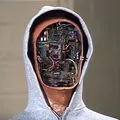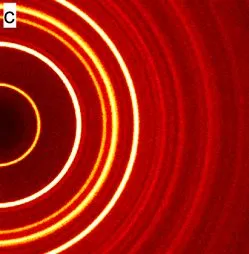I had new progressive lenses made, but the old ones are still fine and don’t have a scratch. They’re just a bit weak at near distance, but otherwise perfectly serviceable.
So I made new frames for them because I don’t like to throw away things that work.
All assembled, the frames weigh 3.5 grams, and 14 grams with the lenses mounted.
This was printed with a Prusa Mk4 and regular PLA at 0.15 mm layer height. The hinges use simple 10x1 pins - and I worked my magic to print the holes horizontally to the final dimension with interference fit, so no reaming or drilling is necessary. These glasses are straight out of the printer with zero rework.
I think they look pretty good as they are. If anybody notices they’re 3D-printed, I’ll say I’m gunning for that particular style 🙂
The front of the frames prints in 11 minutes and both temples in 12 minutes. I could break and make a new pair every day for the rest of my life and it would still be faster and cheaper than going to Specsavers only once.
You’re a printer, harry
Hermione: No Harry, like this
🪄 Reprapario
Or, if you want new ones
🪄 Cuono Deponefacio Exemplum
Actually, there is a company that makes resin printed children’s glasses for about €200 a pop. My son tried them at the opticians and I was impressed by the finish and flexibility. Just to say that 3d printed glasses are really commercially viable.
there is a company that makes resin printed children’s glasses for about €200 a pop
Commercial, high-quality 3D-printed glasses are sold everywhere here in town - including for adults. And they look pretty good too. But I’m more interested in making stuff myself - and for pennies too. What’s the fun in buying ready-made? 🙂
These are cool.
I wonder how these would do if you printed in ABS and then used acetone in a makeshift vapor chamber to smooth and somewhat anneal them?
I think, with them being smoother, they’d be somewhat more comfortable
Although PETG would probably last longer overall since it has some flex/give to it but not sure if there’s any process that lets you “smooth” it like you can with ABS.
Well I could do a lot of things, but one of my hobbies is to model stuff that prints out all ready to go as much as possible. This design uses small metal hinge pins only because printed-in-place functional hinges would be huge.
But otherwise I like that it’s only 3 parts that print quick, don’t require any rework, and still open up to accept the lenses, orient the lenses (I have astigmatism so my lenses need to be rotated exactly right, and if you look carefully on the inside of the hinge, the V groove is interrupted to match a notch in the lens’ bevel, which also contributes to lock the rim closed) and everything holds together smartly with only those two pins.
So yeah, I could do extra work to make them look nicer, but I’m kind of proud to display how I managed to make them look straight out of the printer.
Not to mention, I’m lazy too 🙂
And you know what? That’s a great design philosophy.
Simple and repeatable. Besides you don’t want to risk more expensive lenses with more breakable parts (so the metal hinges make sense)
Lazy wouldn’t have made them so I’d call it efficient use of your time.
When you smooth you do give up some dimensional accuracy.
These days, I more or less exclusively print ASA and PETG. I would call the ASA tougher than PETG, but PETG’s ability to stick to itself when printing makes me prefer it for thin parts. In my experience, PETG also allows for more elastic (temporary/recoverable) deformation before the part undergoes plastic (permanent) deformation.
I have a wall mount for some a pretty hefty stepping stool and it’s been going strong for a few years.
PETG really does handle that well while similar things I’ve printer in PLA broke even with layer line orientation and a lot of walls.
Good stuff.
I’ve had similar experiences. PLA is very stiff, which also makes it brittle. I have quite a few functional PETG that have been going strong for years. Now that I can print ASA too, some of my newer functional prints are transitioning materials.
What about PCTG? Pretty much for anything that I’d need more strength than regular PETG I could go with PETG-CF or PCTG. The only thing that can force me to use ABS/ASA is the need for (more) temperature resistance.
I’ve never heard of PCTG before. A quick Google search and I’ll probably be ordering a spool.
You can smooth PETG with Methylene Chloride, but I would not suggest handling things without proper training and knowledge first
Yeah. Even with acetone you want to be mindful. Nasty stuff and not to be played with lightly.
But interesting application if you can do it safely.
Yes boss! And PLA can be smoothed using clorophorm. Another solution not to handle without safety training
Try explaining that purchase.
It’s for smoothing out something I’m making. So it’ll look and act the way I want.
And the lotion? No officer, no lotion. Where would the lotion go?
Spectacular! Well done!
I see what you did there.
Thanks! 😊
Did you throw in the glasses mid-print? Or how are they fixed?
I’m not OP but if you look close to the outer edges of the frame where they meet at the hinge you can see that the front frame is not “sealed” and lenses can be inserted this way and then fixed with the hinge pin. That’s my guess.
Exactly right.
Nice design. Now is the comfort for long wear? May I ask where you get the lenses from?
I wore them all day yesterday, no problem.
The nose bridge is angled 45 degrees, so it has steps due to the layers of PLA. I expected to have to chemically-polish it with acetone or smooth it out with sandpaper, but I didn’t to test it out, and it turns out to be comfortable as-is. Actually, the steps may provide a bit of additional grip on the skin of my nose.
As for the temples, they’re printed length-wise, so what pushes on my ears is basically a bundle of smooth PLA wires deposted in several smooth swoops. I didn’t do anything to them either.
But I did take a lot of time to model everything to the exact shape of my anatomy. I find that’s what seems to matter the most.
And of course, the whole thing weighs 14 grams. That’s never going to cause a lot of discomfort.
I had the lenses made and mounted to my regular metal frames 2 or 3 years ago by my local optician. Not sure which. Specsavers probably.
No, the rims have a standard hide-a-bevel groove all around, and the hinges are split. You can see it in the 3D model. The lens is inserted into the groove and the hinge is closed by mounting the temple part of the hinge.
What cad software did you use?
FreeCAD
based
Is this legal? I’m calling the police.
This is physical proof of the fast/cheap/good problem.
That is superb. Sadly my eyes degrade faster than the frames wear out!
I see you are on the John Lennon specials which makes it a bit easier to model. I haven’t worn circular specs since college (~1990) My current Tesco specials only have lens frame from the nasal bridge clips, over the top to about 5mm below the temple joints.
Just a thought but you might like to investigate using spring steel for the arms and PLA just for the frames. You could create a jig for joining and heat the ends of the arms up with a brazing torch (kitchen supplies) and sink them into a suitable cylinder close to the temple joint. If you go all in you can make the straight part of the arm rigid and the over ear part flexible with careful heating and cooling and whacking with a hammer!
Now, that metal work will be comfortable but might be a bit chilly. What about PLA tips over ear instead of steel?
Anyway, great job. I’m very impressed.
I haven’t worn circular specs since college (~1990)
I haven’t worn anything but small round glasses since I discovered why they’re just better: small and round lenses can be positioned very close to the eyes, which provides a very large field of vision. And they’re less fragile and prone to breaking if you hit your head on something or snag the end pieces on clothing.
And of course, frames are easier to make. I haven’t bought frames in 30 years. I make my own.
Just a thought but you might like to investigate using spring steel for the arms and PLA just for the frames.
Nah. Those PLA glasses are in fact a copy of a frames I made of silver nicket - and wound spring steel wires for the ear hooks - and having worn them all day for 3 days now, I actually enjoy the feel of PLA better. And it’s so much lighter! It really does make a difference.
And of course, if I break them, I can print another set of temples in minutes. If I don’t like the feel, I can lengthen them or shorten them in FreeCAD and again, within minutes, I have new ones. No more faffing around with the heat gun or anything.
I really dig the disposableness of it all 🙂
Good skills Sir! Advice noted and I will re-evaluate how I do specs.
Thank you.
Would you mind sharing/posting an STL/3MF for these?
Also, is that Galaxy Black filament?
Would you mind sharing/posting an STL/3MF for these?
Sure why not:
https://github.com/Giraut/3D-printed_eyeglasses
Also, is that Galaxy Black filament?
The filament was generic PLA - or perhaps Prusament PLA, which is generic PLA with a fancy name from Prusa, I’m not sure what spool was loaded.
I just threw out glasses over broken frames. Womp womp. This is a great idea for next time.
How many different versions did you have to make?
Designing ergonomic things is a bitch.
Not very many. Those lenses were mounted in silver nickel frames I made myself too, so the ergonomics had been sorted out a long time ago. I simply copied the geometry of my metal frames.
I think I corrected the front of the frames twice - once to lower the greater diameter by 0.5mm because the bevel isn’t completely identlcal to my metal frames’ and once because the Prusa Mk4 didn’t print the nose bridge right, so I added that horizontal bar as a support. And I lenghtened the temples by 5 mm, is all.
If you don’t get yourself a pair of smoked lenses and go Doc Botnik with these, I will be sorely disappointed.
I was able to load this post here manually, but not on lemmy.world.











